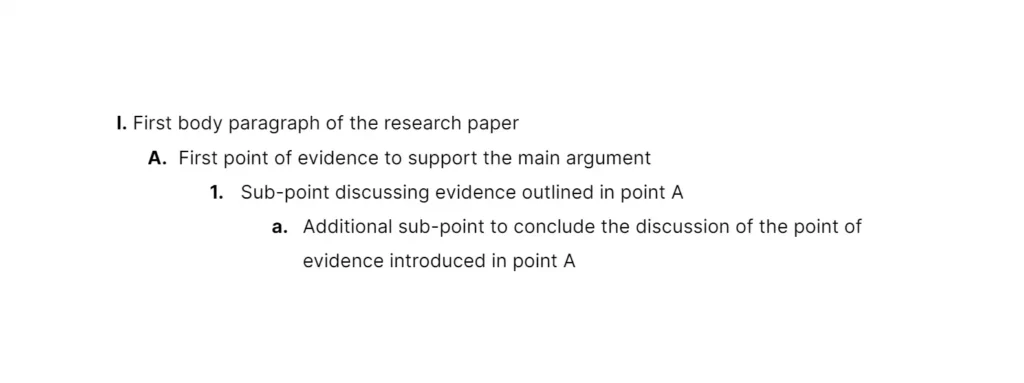A research paper outline is a valuable organizational tool that helps streamline the writing process by providing a clear structure. It ensures that all the necessary information is included and logically arranged.
A well-structured outline offers several benefits, such as:
- Organizing your thoughts: An outline helps you categorize and coherently arrange your ideas, making the writing process more manageable.
- Understanding the flow of information: By creating an outline, you can better visualize how ideas relate to one another and how the information progresses throughout the paper.
- Ensuring completeness: An outline is a checklist that helps you remember to include all the essential points and arguments in your research paper.
Moreover, submitting a research paper outline to your teacher allows them to provide early feedback on your final paper’s proposed structure and content.
Research paper outline example
The following outline is for a research paper on the effects of vaccination on public health, focusing on measles and polio as case studies. The outline presents a comprehensive structure, including an introduction, main arguments, supporting evidence, and a conclusion.
Title: The Impact of Vaccination on Public Health: Measles and Polio
How to write a research paper outline
A research paper outline is a structured plan that helps you organize your thoughts, main points, and supporting evidence before writing your paper. Here are the key steps to follow:
- Identify your research paper’s main topic and formulate a clear thesis statement.
- Brainstorm and write all the ideas, points, and evidence you want to include in your paper. Once you have a comprehensive list, start grouping related ideas together into main sections and subsections.
- Arrange the ideas in a hierarchical structure that reflects the logical flow of your argument. Consider what information the reader should learn first, what points are most crucial to your thesis, and which ideas will help conclude your paper most effectively.
- Create descriptive and informative headings and subheadings for each section of your outline.
- Choose a formatting style for your outline, such as alphanumeric, full-sentence, or decimal.
Formatting your research paper outline
There are three common formats for research paper outlines: alphanumeric, full-sentence, and decimal. Each format has its own structure and style, allowing you to choose the one that best suits your needs and preferences.
Alphanumeric
The alphanumeric format combines letters and numbers to organize your outline’s main points and subpoints. The main sections are denoted by Roman numerals (I, II, III), subsections by capital letters (A, B, C), and further subdivisions by numbers (1, 2, 3) and lowercase letters (a, b, c).
Example

Full-sentence
The full-sentence format uses complete sentences for each point in the outline, providing a more detailed overview of your paper’s content. This format follows the same structure as the alphanumeric outline, using Roman numerals, capital letters, and numbers to denote the hierarchy of points.
Example

Decimal
The decimal format uses a numbering system with decimals to indicate the hierarchy of points in the outline. Main sections are denoted by whole numbers (1.0, 2.0, 3.0), subsections by one decimal place (1.1, 1.2, 1.3), and further subdivisions by additional decimal places (1.1.1, 1.1.2, 1.1.3).
Example

Language in research paper outlines
When creating a research paper outline, it’s essential to use clear and concise language to convey the structure and content of your paper effectively. Four key principles to remember when crafting your outline’s language are parallelism, coordination, subordination, and division.
Parallelism: Be consistent with grammatical form
Parallelism means using the same grammatical form for each point in your outline. This creates consistency and clarity, making your outline easier to read and understand.
Example of parallelism
I. Analyzing the effects of social media on communication
A. Examining the rise of online communication platforms
B. Investigating the impact on face-to-face interactions
C. Assessing the changes in language and grammar usage
In this example, each main point and subpoint begins with a gerund (analyzing, examining, investigating, assessing), maintaining a consistent grammatical form throughout the outline.
Coordination: Be aware of each point’s weight
Coordination involves ensuring that points of equal importance are presented at the same level in your outline. This helps convey each point’s relative significance and maintains a logical hierarchy within your outline.
Example of coordination
I. The benefits of regular exercise
A. Improved cardiovascular health
B. Enhanced mental well-being
C. Increased energy levels
II. The challenges of maintaining a consistent exercise routine
A. Time constraints
B. Lack of motivation
C. Limited access to fitness facilities
In this example, the main points (I and II) are at the same level, and the subpoints (A, B, and C) under each main point are also at the same level, reflecting their equal importance.
Subordination: Work from general to specific
Subordination involves organizing your outline from general to specific ideas. This means that main points should be broader, while subpoints provide more detailed information supporting the main points.
Example of subordination
I. The impact of globalization on the economy
A. Increased international trade
1. Reduced trade barriers
2. Emergence of global supply chains
B. Changes in the labor market
1. Outsourcing of jobs to lower-cost countries
2. Demand for skilled workers in emerging industries
In this example, the main point (I) is the broadest, followed by more specific subpoints (A and B), and even more detailed sub-subpoints (1 and 2).
Division: Break information into sub-points
Division involves breaking down main points into smaller, more manageable subpoints. This helps to organize complex ideas and ensures that each main point is thoroughly supported and explained.
Example of division
I. The causes of climate change
A. Human activities
1. Burning of fossil fuels
2. Deforestation
3. Agricultural practices
B. Natural factors
1. Volcanic eruptions
2. Solar variations
3. Earth’s orbital changes
In this example, the main point (I) is divided into two subpoints (A and B), which are further divided into sub-subpoints (1, 2, and 3) to provide a more detailed breakdown of the information.